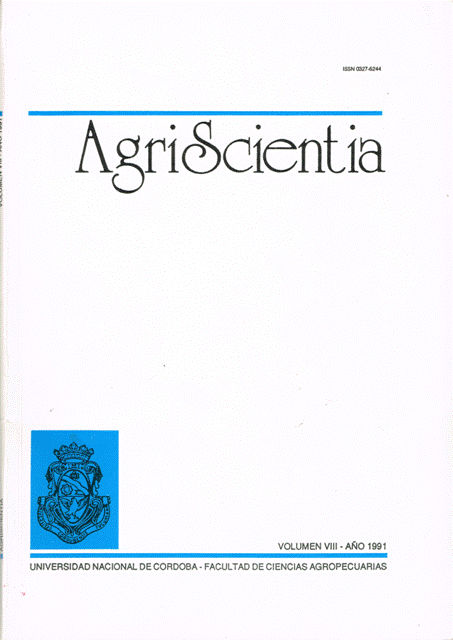Micropropagation of Actinidia chinensis Pl. (kiwifruit). Nursery performance of micropropagated plants and their comparison with rooted cuttings
Main Article Content
Abstract
Micropropagated plants of Actinidia chinensis Pl. with a height of about 5 cm, 2 expanded leaves, and 2-3 roots were successfully hardened by using a polyethylene tunnel in a glasshouse. The hardening was possible from September to January. The best results were obtained in November and December, with a recovery of 70.8% and 81.5%, respectively. The rooting of woody cuttings was achieved by treating them with a solution of IBA (1000 ppm for 24 h) and planting them under the same conditions to compare their growth with the micropropagated ones. Fresh and dry weights of roots and shoots were evaluated after 11 months of growth under nursery conditions. Micropropagated plants were between 11 to 14 times larger than those produced by the rooted cuttings.
Article Details

This work is licensed under a Creative Commons Attribution-ShareAlike 4.0 International License.
How to Cite
References
Bini, G., 1979. Moltiplicazione in vitro di Actinidia chinensis PI. Comunicazione presentata all’Incontro su: "Tecniche di colture in vitro per la propagazione su vasta scala delle specie ortoflorofrutticole", Pistola. 211-218.
Hackett, W.T., 1985. Juvenility, maturation, and rejuvenation in woody plants. Hort. Rev., 7: 109-155.
Harada, H., 1975. Research note in vitro organ culture of Actinidia chinensis Pl. as a technique for vegetative multiplication. J. Hortic. Sci., 50: 81-83.
Huang, Z.G. & Tan, C.Y., 1988. Chinese gooseberry, Kiwifruit (Actinidia spp.). In: Biotechnology in Agriculture and Forestry 6: Crops II. Ed. by Y.P.S. Bajat. Springer-Verlag, Berlin Heidelberg. 166-180.
Jones, O.P. & Hadlow, W.C.C., 1989. Juvenile-like character of apple trees produced by grafting scions and rootstocks produced by micropropagation. J. Hort. Sci., 64(4): 395-401.
Loreti, F. & Morini, S., 1982. Mass propagation of fruit trees in Italy by tissue culture - present status and perspectives. Comb. Proc. Intl. Plant Prop. Soc., 32: 283-291.
Martin, C., Carre, M. & Vernoy, R., 1983. La multiplication vegetative in vitro des vegetaux ligneux cultives, cas des arbres frutiers et discussion generale. Rev. Agron., 3: 303-306.
Monette, P.L., 1986. Micropropagation of Kiwifruit using non-axenic shoot tips. Plant Cell Tissue and Org. Cult., 5: 73-82.
Radice, S. & Caso, O.H., 1991. Micropropagación de Actinidia chinensis Planch (Kiwi) - Optimización del medio de cultivo para la propagación clonal en gran escala. Agriscientia, VIII: 55-60.
Rosati, P., Gaggioli, D. & Giunchi, L., 1986. Genetic stability of micropropagated loganberry plants. J. Hort. Sci., 61(1): 33-41.
Rosati, P. & Gaggioli, D., 1987. Field performance of micropropagated peach rootstocks and scion cultivars of sour cherry and apple. Acta Hort., 212: 379-390.
Sim, B.L. & Lawes, S.G., 1981. Propagation of Kiwifruit from stem cuttings. Gartenbauwissenschaft, 46(2): 65-68.
Standardi, A., 1981. Micropropagazione dell’Actinidia chinensis PI. mediante coltura in vitro di apici meristematici. Frutticoltura, 43(1): 23-27.
Standardi, A., 1982. Effects of repeated subculture in shoots of Actinidia chinensis PI. Proc. 5th Intl. Cong. Plant Tissue & Cell Cult., 739-740.
Standardi, A., 1983. La micropropagazione nella moltiplicazione dell’actinidia. Frutticoltura, 45(2): 17-22.
Standardi, A. & Catalano, F., 1985. Tissue culture propagation of Kiwifruit. The International Plant Propagators' Society Combined Proceedings (1984): 236-243.
Swartz, H.J., Gallota, G.J. & Zimmerman, R.H., 1983. Field performance and phenotypic stability of tissue culture-propagated thornless blackberries. J. Amer. Soc. Hort. Sci., 108: 285-290.
Webster, A.D., Oehl, V.D., Jackson, J.E. & Jones, O.P., 1985. The orchard establishment, growth and precocity of four micropropagated apple scion cultivars. J. Hort. Sci., 60: 169-180.
Wainwright, H. & Flegmann, W., 1985. The micropropagation of gooseberry (Ribes uva-crispa Q.). II In vitro proliferation and in vivo establishment. J. Hortic. Sci., 60(4): 485-491.





